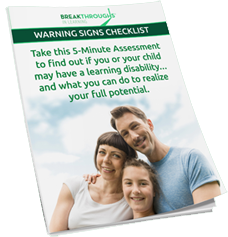
Does it affect life at home, at school or at work?
Take 5 minutes to complete the Warning Signs Checklist and discover whether you or your child could have learning difficulties that are impacting your life, and what to do about it.
Take The Free Warning Signs Checklist!
Experiencing anxiety is quite normal. Anxiety helps us avoid danger and it is often the typical response to particular situations, such as important tests and public speaking. However, when anxiety becomes a generalized reaction to many situations, no matter their actual danger, then it starts to negatively affect quality of life and achievement.
For a child who already experiences anxiety, returning to school can intensify the nervousness. Back to school anxiety will not only cause dread but it may manifest as physical symptoms when that first day of school arrives. Children may often claim they need a sick day or make other attempts to avoid that day, a big test or presentation. You can help your child see the first day of school as a positive experience and reduce the nervousness if you follow a few simple steps.
Step #1: Show Empathy
If your child could stop back to school anxiety, she would. Anxiety is unpleasant and no one wants to feel that panic. Acknowledge the anxious feelings and understand they are quite painful and real. Taking this understanding approach helps your child be more open about the anxiety and reduces any additional stress she may feel about disappointing you. Knowing you understand and are there for her will greatly reduce your child’s anxiety.
Step #2: Encourage Mindfulness
Mindfulness is being there in one moment and shutting out the intrusive thoughts that tend to add to anxiety. Encourage your child to spend even one minute listening to birds or play some favorite soothing music, during which time nothing is asked of your child. This forces back to school anxiety to take a break and move to the background, even if just for a short time. That reduces its effect.
Step #3: Focus on the Positive
While your child may stay focused on peer pressure, homework or fear of bullying, help him turn that focus to more positive attributes of school including the excitement of learning, fun games in gym or recess and even gratitude towards a supportive teacher. Encourage this trend by having your child tell you at the end of each school day about one thing that went right for him.
This helps with coping skills if your child makes a mistake or finds difficulty with unexpected developments. By making a focus on positive attributes a habit, your child may have an easier time focusing on something good even in stressful situations.
Step #4: Work Exercise into Each Day
Even if all your child does is walk the dog or throw a Frisbee around for a bit, exercise is shown to be one of the best anti-anxiety and anti-depressant influences. It literally diverts energy from anxiety into movement, encouraging a better sense of well being. Exercise even releases serotonin and dopamine in your brain, reducing anxiety and improving your mood.
 Step #5: Show Affection
Step #5: Show Affection
Hugs or just holding them stimulates oxytocin, a natural anxiety-controlling hormone. Never forget to hug your child. Evidence shows that it actually helps reduce all negative emotions.
Back to school anxiety is understandable but it does not need to be debilitating. By being a positive and encouraging influence as your child nears the first day of school, you can guide their thoughts towards the positive excitement of the day and away from any stress they may face.
Subscribe to our newsletter and receive regular articles and resources to help you or your child perform better at school, home or work.
suscribe now
Post Your Comment Below